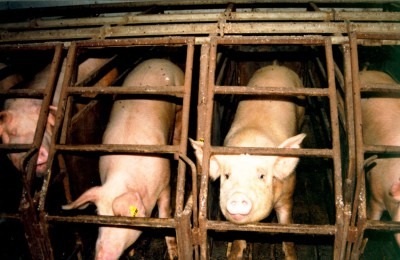First, and foremost, on the issue of directly or indirectly harming (read: killing) other individuals of other species, inherent to the entire message by the Pope, who says we must stop collaborating in the death of others: what would that mean to the Earth, starting from today? This is the single injunction we should like to examine, for it is at the core of the entire third Encyclical of Franciscus.

Rather than elucidating and hammering with sheer numbers, we have chosen to symbolize the vast extent of killing by enumeration of some (43, out of 125) of the most critical indicators, or “Pain Points” as we have long identified the cruel intersections of human behavior and the global environment, a cartography of those aggregates wherein the most pain and needless cruelty and destruction are inflicted by our kind on all the biomes and organisms that live therein. [4]
Some Critical Pain Points
Annual human consumption of animals, including: all bovines, ovine’s, porcines, Gallus, and others
Live animal shipments, carcasses, miscellaneous body parts
Number of slaughterhouses
Total number of animals per slaughterhouse
Total number of animal industries
Animal related-industry tax subsidies
Gross domestic losses from tax subsidies to total animal-related industries
Income derived from total number of animal industries
Religious exemptions by law in respect to total number of animals involved in their own deaths
Total number of animals exploited for biomedical research
Number of animals tested and re-tested before their deaths
Number of animals killed without pain alleviation
Total number of animals that qualify as road-kill and air-kill
Total number of animals killed by the military
Total number of animals killed by environmental agencies/divisions
Total number of animals killed in consumer product testing
Total number of animals killed by human-induced fires
Total number of animals killed in the name of biosecurity
Total number of animals that qualify as by-kill
Total number of animals eaten alive by humans
Total number of animals killed – in general – by human development
Total number of threatened species (by any national or international criteria)
Total number of zoos
Pollution indices as pertaining to total domestic animal populations and downstream and/or edge effects on habitat, including air quality, soil quality, ground water, aquifers, riparian systems, lakes, wetlands, coastal areas, forests and shrubland; seven critical biological zones that include alpine, temperate, cool temperate, warm temperate, dry subtropical, humid subtropical, and wet subtropical; and all of the critical forest types, including mixed broadleaf podocarp, conifer, fir, upland and lowland hardwoods, etc.
Destruction or usurpation of wild habitat by animal related industries
Total economic losses from total number of farm animals as measured by biodiversity loss and impact on other free nature’s services
Human epidemiology as pertains to morbidity and mortality linked to animal captivity and products
Pet industries
Illegal pet industries
Convention on International Trade in Endangered Species violations
Animal control statistics (e.g., killing of “predators” on public and private lands)
Total number of hunted animals
Subsidized hunting regimes
Total value of hunting to the economy versus non-hunting tariffs –e.g., duck stamp revenues, local economic benefits from sale of rifles, guns, bullets, etc –versus total revenue generated from bird watching, photographic safaris, and other non-lethal recreational activities
Total number of murdered animals divided by total number of hunters (worldwide)
Total number of convictions for those illegally possessing or trading wildlife
Citations for pet store owner violations
Total number of animal abuse cases
Fresh water and marine vertebrate consumption data
Total number of dead-zones
Total number of no-kill marine zones
Fresh water and marine invertebrate consumption data
Total number of fishing violations
In sum, the Authors have posited an easily captured set of global criteria for estimating the extent of human violence meted out to others; a general tabulation that does not even account for intra-species violence, but, by illimitable means introduces the breakdown of our violence towards other persons in the biological arena known loosely as Earth. [5]
For each of these data sets exists a mindful mitigation that, with even the slightest legal, ethical, educational, economic and geopolitical willpower might yet undermine the pernicious trends our species has long favored for its own ends.
Climate change is but a telling sub-set, or reminder, of the cumulative, mindless violence we have triggered in the name of species solipsism. If one includes bacteria and viruses, the planet unquestionably contains possibly in excess of one hundred million species. Each species, in turn, on average, comprises millions of individuals, in some cases billions (e.g., the sub-Saharan red-billed quelea, Quelea quelea, or the marine cyanobacteria genus Prochlorococcus, about 3-times-ten-to-the 27th individuals). [6]
The fact we have surveyed fewer than 1.75 million species, to date, yet can already identify the unambiguous reality of a human-induced Anthropocene now sweeping the planet should overwhelmingly qualify Pope Francis’s “Encyclical” as a benchmark in the modern history of environmentalism, nothing less than a massive summons for animal liberation. It also coincides in a most timely manner with the Global Genome Project, intent upon saving representatives of the “500 plant families and more than 13,000 genera” on Earth. [7]
Every human being capable of reading, or hearing the lyrical, hard-hitting, emphatic animal and plant rights treatise, generated this May 24th from the Vatican has no excuse any longer for inaction in the defense of nature. This is, indeed, a call of Mayday.
Footnotes:
- http://w2.vatican.va/content/francesco/en/encyclicals/documents/papa-francesco_20150524_enciclica-laudato-si.html
- http://www.st-josephstatue.com/st_joseph_articles_details/saint_francis.htm
- http://www.acton.org/public-policy/environmental-stewardship/theology-e/orthodox-churches-statement-environment
- God’s Country: The New Zealand Factor, pp. 367-373, freely downloadable from:
- http://www.dancingstarbooksfilms.org/gods-country-the-new-zealand-factor/
- ibid.
- http://microbewiki.kenyon.edu/index.php/Prochlorococcus, said to contribute possibly as much as “30-80% of primary production” in those regions of the world’s (oligotrophic) oceans that are characterized, otherwise, as low in nutrition. Hence, this minute organism has an enormous impact on the atmospheric chemistry of the planet.
- http://www.bbc.com/news/magazine-33438201; Dancing Star Foundation has been advocating for the GGP to add the rich terrestrial flora of Antarctica to its initiative.
The authors, Michael Charles Tobias and Jane Gray Morrison retain all rights to the above content. Find out more about the Dancing Star Foundation through its MAHB Node. © Michael Charles Tobias, Jane Gray Morrison, 2015
MAHB-UTS Blogs are a joint venture between the University of Technology Sydney and the Millennium Alliance for Humanity and the Biosphere. Questions should be directed to joan@mahbonline.org
MAHB Blog: https://mahb.stanford.edu/blog/pope-francis-on-animal-liberation/
The views and opinions expressed through the MAHB Website are those of the contributing authors and do not necessarily reflect an official position of the MAHB. The MAHB aims to share a range of perspectives and welcomes the discussions that they prompt.
